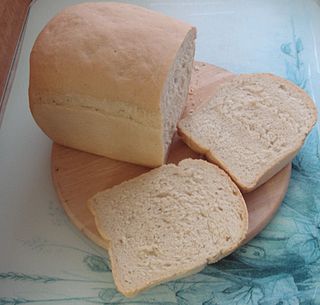 W
WBaking is a method of preparing food that uses dry heat, typically in an oven, but can also be done in hot ashes, or on hot stones. The most common baked item is bread but many other types of foods are baked. Heat is gradually transferred "from the surface of cakes, cookies, and breads to their center. As heat travels through, it transforms batters and doughs into baked goods and more with a firm dry crust and a softer center". Baking can be combined with grilling to produce a hybrid barbecue variant by using both methods simultaneously, or one after the other. Baking is related to barbecuing because the concept of the masonry oven is similar to that of a smoke pit.
 W
WAsh cake is a type of bread baked over a layer of heated stones or sand and covered-over in hot ashes, a practice still found principally in Arabian countries, especially among Bedouins.
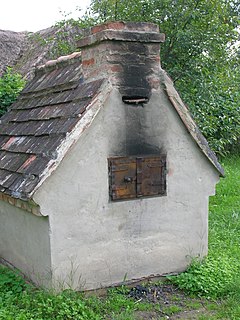 W
WA bakehouse is a building for baking bread. The term may be used interchangeably with the term "bakery", although the latter commonly includes both production and retail areas.
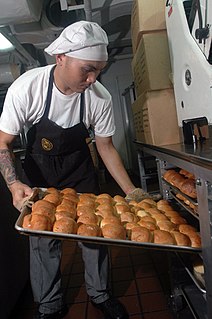 W
WA baker is a tradesperson who bakes and sometimes sells breads and other products made of flour by using an oven or other concentrated heat source. The place where a baker works is called a bakery.
 W
WA bakestone is a type of griddle, particularly associated with Wales, where they are used for cooking Welsh cakes.
 W
WBaking chocolate, also referred to as bitter chocolate, cooking chocolate and unsweetened chocolate, is a type of dark chocolate that is prepared for use as an ingredient in baking.
 W
WBarbecue or barbeque is a cooking method or device, a style of food, and a name for a meal or gathering at which this style of food is cooked and served.
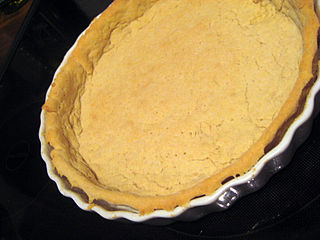 W
WBaking blind is the process of baking a pie crust or other pastry without the filling. Blind baking a pie crust is necessary when it will be filled with an unbaked filling, in which case the crust must be fully baked. It is also called for if the filling has a shorter bake time than the crust, in which case the crust is partly baked. Blind baking is also used to keep pie crust from becoming soggy due to a wet filling.
 W
WA bread making machine or breadmaker is a home appliance for turning raw ingredients into baked bread. It consists of a bread pan, at the bottom of which are one or more built-in paddles, mounted in the center of a small special-purpose oven. This small oven is usually controlled by a simple built-in computer using settings input via a control panel. Most bread machines have different cycles for different kinds of dough—including white bread, whole grain, European-style, and dough-only. Many also have a timer to allow the bread machine to activate without operator attendance, and some high-end models allow the user to program a custom cycle.
 W
WChocolate is a preparation of roasted and ground cacao seeds that is made in the form of a liquid, paste, or in a block, which may also be used as a flavoring ingredient in other foods. The earliest signs of use are associated with Olmec sites suggesting consumption of chocolate beverages, dating from the 19th century BC. The majority of Mesoamerican people made chocolate beverages, including the Maya and Aztecs. The English word "chocolate" comes, via Spanish, from the Classical Nahuatl word xocolātl.
 W
WIn baking, a farinograph measures specific properties of flour. It was first developed and launched in 1928. The farinograph is a tool used for measuring the shear and viscosity of a mixture of flour and water. The primary units of the farinograph are Brabender Units, an arbitrary unit of measuring the viscosity of a fluid.
A ferment is a fermentation starter used in indirect methods of bread making. It may also be called mother dough.
 W
WThe Gâteau Affairs (情迷黑森林) is a 20 episode TVB series in late 2004 and early 2005. It stars Joe Ma (馬德鐘), Myolie Wu (胡杏兒), Bobo Chan (陳文媛), Jack Wu (胡諾言) and Annie Man (文頌嫻). Bobo Chan provides the voice for the theme song. Gâteaux was misspelt as "Gâteux" for all scenes and captions within the series.
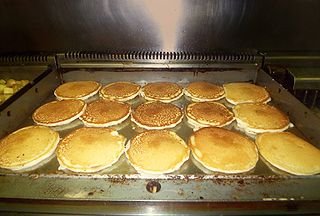 W
WA griddle is a cooking device consisting of a broad flat surface heated by gas, electricity, wood, or coal, with both residential and commercial applications. In industrialized countries, a griddle is most commonly a flat metal plate, elsewhere typically a brick slab or tablet.
 W
WIn cooking, kneading is a process in the making of bread or dough, used to mix the ingredients and add strength to the final product. Its importance lies in the mixing of flour with water; when these two ingredients are combined and kneaded, the gliadin and glutenin proteins in the flour expand and form strands of gluten, which gives bread its texture. The kneading process warms and stretches these gluten strands, eventually creating a springy and elastic dough. If bread dough is not kneaded enough, it will not be able to hold the tiny pockets of gas created by the leavening agent, and will collapse, leaving a heavy and dense loaf.
 W
WThe Kuo Yuan Ye Museum of Cake and Pastry is a pastry culture and making museum in Taiwan.
 W
WLaminated dough is a culinary preparation consisting of many thin layers of dough separated by butter, produced by repeated folding and rolling. Such doughs may contain over eighty layers. During baking, water in the butter vaporizes and expands, causing the dough to puff up and separate, while the lipids in the butter essentially fry the dough, resulting in a light, flaky product. Examples of laminated doughs include:Croissant pastry Danish pastry Flaky pastry Jachnun Kubaneh Paratha Puff pastry
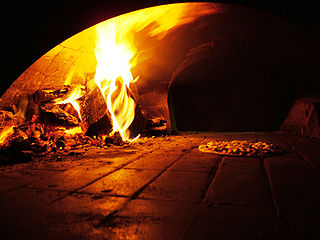 W
WA masonry oven, colloquially known as a brick oven or stone oven, is an oven consisting of a baking chamber made of fireproof brick, concrete, stone, clay, or cob. Though traditionally wood-fired, coal-fired ovens were common in the 19th century, and modern masonry ovens are often fired with natural gas or even electricity. Modern masonry ovens are closely associated with artisanal bread and pizza, but in the past they were used for any cooking task involving baking. Masonry ovens are built by masons.
 W
WNappage or apricot glaze is a baking technique. Jam made from apricots is diluted with water to form a transparent, slightly apricot-colored glaze. The glaze is used to cover fruit on a fruit tart or other baked goods, to make the fruit pieces shiny, prevent them from drying out, and to retard oxidation.
 W
WNo-knead bread is a method of bread baking that uses a very long fermentation (rising) time instead of kneading to form the gluten strands that give the bread its texture. It is characterized by a low yeast content and a very wet dough. Some recipes improve the quality of the crust by baking the bread in a Dutch oven or other covered vessel.
 W
WParchment paper, or vegetable parchment, is a cellulose-based composite that has been processed to give it additional properties like non-stick, grease resistance, resistance to the humid state. It is commonly used in baking as a disposable non-stick, grease resistant surface. It should not be confused with wax paper or waxed paper, which is paper that has been coated in wax.
 W
WPores are the air pockets found in leavened bread, where carbon dioxide from the fermentation process creates a network of primarily interconnected void structures. The degree to which pores form are a major determiner in the texture ("crumb") of the bread. Pore size varies between varieties of bread. Sourdough bread is a variety with larger pores. Rye bread has smaller pores and a denser crumb.
 W
WThe primitive clay oven, or earthen oven / cob oven, has been used since time immemorial by diverse cultures and societies, primarily for, but not exclusive to, baking before the invention of cast-iron stoves, and gas and electric ovens. The general build and shape were, mostly, common to all peoples, with only slight variations in size and in materials used to construct the oven. In primitive courtyards and farmhouses, earthen ovens were built on the ground.
 W
WIn cooking, proofing is a step in the preparation of yeast bread and other baked goods where the dough is allowed to rest and rise a final time before baking. During this rest period, yeast ferments the dough and produces gases, thereby leavening the dough.
 W
WA rolling pin is a cylindrical food preparation utensil used to shape and flatten dough. Two styles of rolling pin are found: rollers and rods. Roller types consists of a thick cylinder with small handles at each end; rod type rolling pins are usually thin tapered batons. Rolling pins of different styles and materials offer varying advantages, as they are used for different tasks in cooking and baking.
 W
WA Russian stove is a unique type of masonry stove that first appeared in the 15th century. It is used both for cooking and domestic heating in traditional Russian, Ukrainian and Belarusian households. The Russian stove burns firewood or wood manufacturing waste.
 W
WSaccharomyces cerevisiae is a species of yeast. The species has been instrumental in winemaking, baking, and brewing since ancient times. It is believed to have been originally isolated from the skin of grapes. It is one of the most intensively studied eukaryotic model organisms in molecular and cell biology, much like Escherichia coli as the model bacterium. It is the microorganism behind the most common type of fermentation. S. cerevisiae cells are round to ovoid, 5–10 μm in diameter. It reproduces by budding.
 W
WStraight dough is a single-mix process of making bread. The dough is made from all fresh ingredients, and they are all placed together and combined in one kneading or mixing session. After mixing, a bulk fermentation rest of about 1 hour or longer occurs before division. It is also called the direct dough method.
 W
WWater roux is a paste of flour cooked in water or milk which is used to improve the texture of bread, making it soft and fluffy. For yu-dane the flour is mixed with an equal weight of boiling water poured over it. However, "scalding" flour, especially rye flour, for baking is a technique that has been used for centuries. This mixture then holds moisture so that, when it is added to a bread mix, the dough bakes with a soft, fluffy texture and the bread then keeps for longer. For tangzhong the flour is cooked at 65°C in the liquid which causes its starch to gelatinize. When the gelatinized roux is refrigerated it apparently also contributes to slightly greater rise during baking.
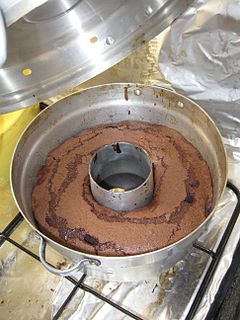 W
WWonder Pot is an Israeli invention for baking on top of a gas stove rather than in an oven. It consists of three parts: an aluminium pot shaped like a Bundt pan except smooth-sided rather than fluted, a hooded cover perforated with venting holes, and a thick, round, slightly domed metal disc with a center hole that is placed between the pot and the flame.
 W
WWood-fired ovens, also known as wood ovens, are ovens that use wood fuel for cooking. There are two types of wood-fired ovens: "black ovens" and "white ovens". Black ovens are heated by burning wood in a chamber. Food is cooked in that same chamber while the fire is still going, or in the heated chamber after the fire and coals have been swept out. White ovens are heated by heat transfer from a separate combustion chamber and flue-gas path. Thus, the oven remains "white", or clean from ash. While the traditional wood-fired oven is a masonry oven, such ovens can also be built out of adobe, cob or cast iron.